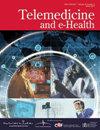Are Virtual Complementary and Integrative Therapies as Effective as In-Person Therapies? Examining Patient-Reported Outcomes Among Veterans with Chronic Musculoskeletal Pain.
IF 2.8
3区 医学
Q2 HEALTH CARE SCIENCES & SERVICES
引用次数: 0
Abstract
Background: Virtual complementary and integrative health (CIH) therapy availability increased during the COVID-19 pandemic, but little is known about effectiveness. We examined the perceived effectiveness of in-person and virtual CIH therapies for patients with chronic musculoskeletal pain who recently started using CIH therapies. Methods: The sample included Veterans (n = 1,091) with chronic musculoskeletal pain, identified in the Veterans Health Administration's electronic health record based on initiation of CIH therapy use, who responded to VA's Patient Complementary and Integrative Health Therapy Experience Survey during March, 2021, to August, 2022. Using multivariable models with self-guided virtual (apps or videos) delivery as the reference, we compared patient-reported outcomes (pain, mental health, fatigue, and general well-being) associated with any yoga, Tai Chi/Qigong, or meditation use delivered: (1) only in-person, (2) only virtually with a live provider, (3) only virtually self-guided, (4) virtually self-guided + virtually provider-guided, or (5) hybrid in-person + virtual (self-or provider-guided). Results: Under 10% of Veterans reported only in-person use; 54% used only virtual formats and 36% a hybrid of in-person and virtual. Forty-one percent reported improvement in general well-being, 40.6% in mental health, 37.1% in pain, and 22.7% in fatigue. Compared with Veterans using only self-guided virtual CIH therapies, Veterans using only in-person therapies were more likely to report improvement in fatigue (odds ratio [OR]: 1.8, confidence interval [CI]: 1.1-3.1) and general well-being (OR: 1.7, CI: 1.0-2.6). Conclusions: Many patients perceived health improvements from CIH therapies, with in-person users reporting more improvement in fatigue and well-being than those using virtual sessions and similar improvements in pain and mental health for in-person and hybrid users.虚拟补充和综合疗法与面对面疗法一样有效吗?研究患有慢性肌肉骨骼疼痛的退伍军人的患者报告结果。
背景:在 COVID-19 大流行期间,虚拟补充和综合保健(CIH)疗法的可用性有所增加,但人们对其有效性知之甚少。我们研究了最近开始使用 CIH 疗法的慢性肌肉骨骼疼痛患者对现场和虚拟 CIH 疗法有效性的感知。研究方法样本包括退伍军人(n = 1,091),他们患有慢性肌肉骨骼疼痛,根据开始使用 CIH 疗法的时间在退伍军人健康管理局的电子健康记录中进行了确认,并在 2021 年 3 月至 2022 年 8 月期间对退伍军人健康管理局的患者补充和综合健康疗法体验调查做出了回应。我们使用多变量模型,以自我指导的虚拟(应用程序或视频)交付作为参考,比较了与任何瑜伽、太极/气功或冥想使用相关的患者报告结果(疼痛、心理健康、疲劳和总体幸福感):(1) 仅面对面,(2) 仅与现场提供者虚拟,(3) 仅虚拟自我指导,(4) 虚拟自我指导 + 虚拟提供者指导,或 (5) 混合面对面 + 虚拟(自我或提供者指导)。结果:不到 10%的退伍军人表示只使用了面对面指导;54%的退伍军人只使用了虚拟指导,36%的退伍军人混合使用了面对面指导和虚拟指导。41%的退伍军人表示总体健康状况有所改善,40.6%的退伍军人表示心理健康有所改善,37.1%的退伍军人表示疼痛有所改善,22.7%的退伍军人表示疲劳有所改善。与只使用自我指导的虚拟 CIH 疗法的退伍军人相比,只使用面对面疗法的退伍军人更有可能报告疲劳(几率比 [OR]:1.8,置信区间 [CI]:1.1-3.1)和总体健康(几率比:1.7,置信区间:1.0-2.6)有所改善。结论许多患者认为CIH疗法改善了他们的健康状况,与使用虚拟疗程的患者相比,亲临现场的患者在疲劳和健康方面的改善程度更大,而亲临现场和混合使用的患者在疼痛和心理健康方面的改善程度相似。
本文章由计算机程序翻译,如有差异,请以英文原文为准。
求助全文
约1分钟内获得全文
求助全文
来源期刊

Telemedicine and e-Health
医学-卫生保健
CiteScore
8.80
自引率
6.40%
发文量
270
审稿时长
2.3 months
期刊介绍:
Telemedicine and e-Health is the leading peer-reviewed journal for cutting-edge telemedicine applications for achieving optimal patient care and outcomes. It places special emphasis on the impact of telemedicine on the quality, cost effectiveness, and access to healthcare. Telemedicine applications play an increasingly important role in health care. They offer indispensable tools for home healthcare, remote patient monitoring, and disease management, not only for rural health and battlefield care, but also for nursing home, assisted living facilities, and maritime and aviation settings.
Telemedicine and e-Health offers timely coverage of the advances in technology that offer practitioners, medical centers, and hospitals new and innovative options for managing patient care, electronic records, and medical billing.
 求助内容:
求助内容: 应助结果提醒方式:
应助结果提醒方式:


